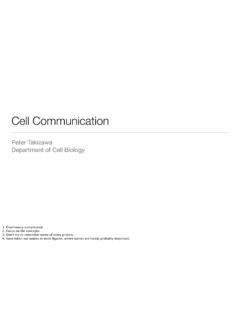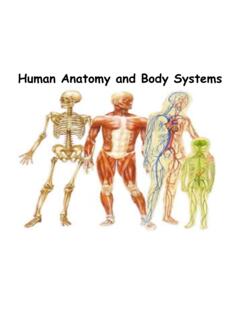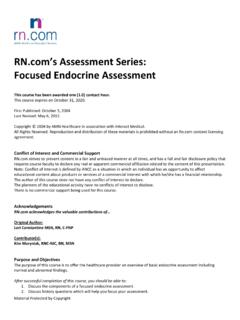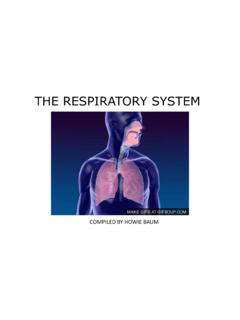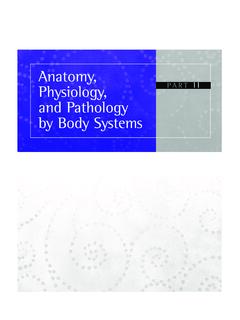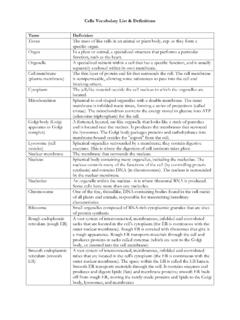Transcription of Epithelial Structure - Yale University
1 Epithelial StructurePeter TakizawaDepartment of Cell Biology Type of epithelia Adhesion between Epithelial cells Basement membrane Epithelial cell polarity Cell renewalAll organs contain epithelia in some are a collection of cells that form functional unit. Most epithelia form a sheet of cells. Epithelia line most body surfaces, including the skin digestive tract, respiratory tract and all body cavities . They form the functional unit and ducts of secretory glands. Epithelia are also the inner lining of all blood vessels and lymphatics.
2 ~85% of cancers derive from perform a variety of serve a number of functions. They offer protection to organs such as the skin. The absorb material in the intestine. They secrete material in glands. And they allow for passive diffusion of gases in the lung and blood and shape of cells in epithelium facilitate its accomplish these different functions, epithelia come in a variety of structures. Most epithelia are classified based on two criteria: shape and layers of cells. A single layer of cells is called simple whereas a epithelium with two or more layers of cells is called stratified.
3 If the most superficial layer of cells is flat, the epithelium is referred to as squamous. Squamous epithelia facilitate diffusion of gases and other small molecules. Epithelia where the cells are about as tall as they are wide are called cuboidal. If the cells are taller than they are wide, then they are called columnar. Cuboidal and columnar cells are usually involved in secretion and/or absorption and need more cytoplasmic volume to accommodate the organelles needed for these activities. Two special types of epithelia are pseudostratified and between Epithelial cells are held together by three junctional junctionsDesmosomesGap junctionsIntegrinsTight JunctionsEpithelial cells are held together by three junctional complexes.
4 All epithelia will have adhering junctions, but only some will have desmosomes. Epithelia also contain tight junctions which control the diffusion of material between epithelia junctions form a belt-like adhesion zone around Epithelial junctions have characteristic arrangement in Epithelial cells. They form continuous belt around the circumference of Epithelial cells. The adherins junction are linked to bundles of actin filaments that also wrap around the cell. Myosin filaments can pull on the actin filaments to contract the cell. Because the adherins junctions are located closer to the apical surface, contraction causes the apical surface to shrink.
5 This allows epithelia to form a tube from a sheet of junctions form a belt-like adhesion zone around Epithelial junctions have characteristic arrangement in Epithelial cells. They form continuous belt around the circumference of Epithelial cells. The adherins junction are linked to bundles of actin filaments that also wrap around the cell. Myosin filaments can pull on the actin filaments to contract the cell. Because the adherins junctions are located closer to the apical surface, contraction causes the apical surface to shrink. This allows epithelia to form a tube from a sheet of junctions: controlling paracellular diffusionTight junctions prevent diffusion of molecules between Epithelial usually separate two compartments.
6 Often one compartment is an external space or lumen of a tube and the other is the rest of a tissue or organ. The apical side of the Epithelial cells faces the external space or lumen and the basal side faces the rest of the organ. One role for epithelia is to control the mixing of material between the two compartments. To accomplish this, epithelia must control the ability of small molecules and ions to diffuse between cells or paracellular diffusion. Tight junctions that link adjacent Epithelial cells determine how permeable an epithelia is to ions and small molecules.
7 Some epithelia are very permeable ( intestine) where as others are restrictive ( bladder).Tight junctions form a network of sealing strands that encircle Epithelial junctions are similar to adhering junctions in that they encircle the entire circumference of cell. They bring together the cell membranes of adjacent cells. Tight junctions consist of set of strands that are defined by protein-protein interactions between adjacent are the primary functional component of tight 1 Cell 2 Tight junctions contain more than 50 different types of proteins.
8 Claudins are the proteins that primarily determine the permeability of the tight junction. Claudins contain four transmembrane domains and interact with cluadins in adjacent cells. The intracellular domains of claudins are linked indirectly to actin filaments by a set of proteins called ZO proteins. The interaction with actin filaments help stabilize the claudins in the cell membrane. Also, myosin filaments can generate tension on the actin filaments to loosen the tight are the primary functional component of tight junctions contain more than 50 different types of proteins.
9 Claudins are the proteins that primarily determine the permeability of the tight junction. Claudins contain four transmembrane domains and interact with cluadins in adjacent cells. The intracellular domains of claudins are linked indirectly to actin filaments by a set of proteins called ZO proteins. The interaction with actin filaments help stabilize the claudins in the cell membrane. Also, myosin filaments can generate tension on the actin filaments to loosen the tight between claudins generates size restrictive extracellular domains of claudins interact to form size-restrictive pores.
10 The permeability of an ion or molecule is inversely related to between claudins generates size restrictive extracellular domains of claudins interact to form size-restrictive pores. The permeability of an ion or molecule is inversely related to of tight junctions varies by type claudin expressed in IntestineLarge IntestineBladderThe permeability of epithelia varies between organs up to 10,000 fold difference. The epithelia of the small intestine is more permeable that the epithelia of the bladder. There are 24 different claudin genes and each encodes a protein with different permeability properties.



